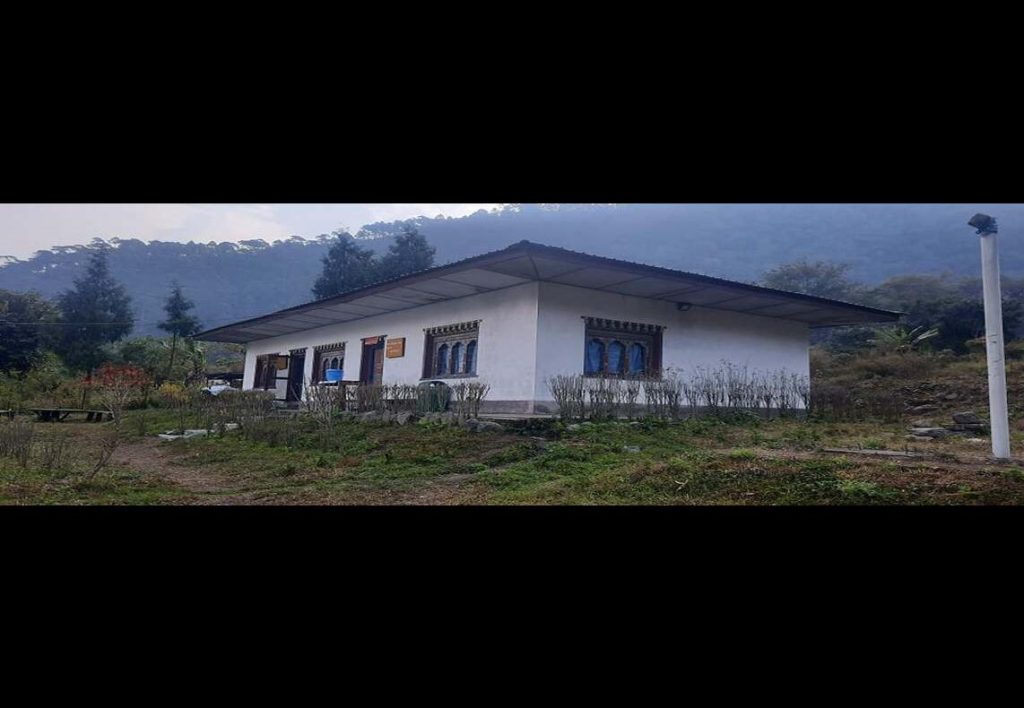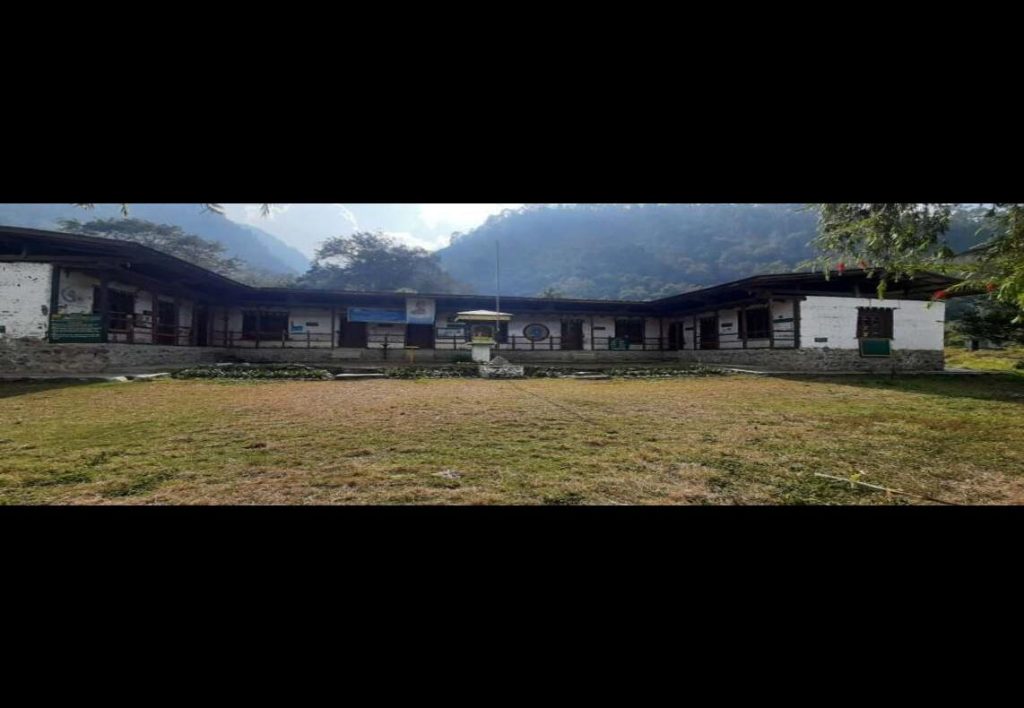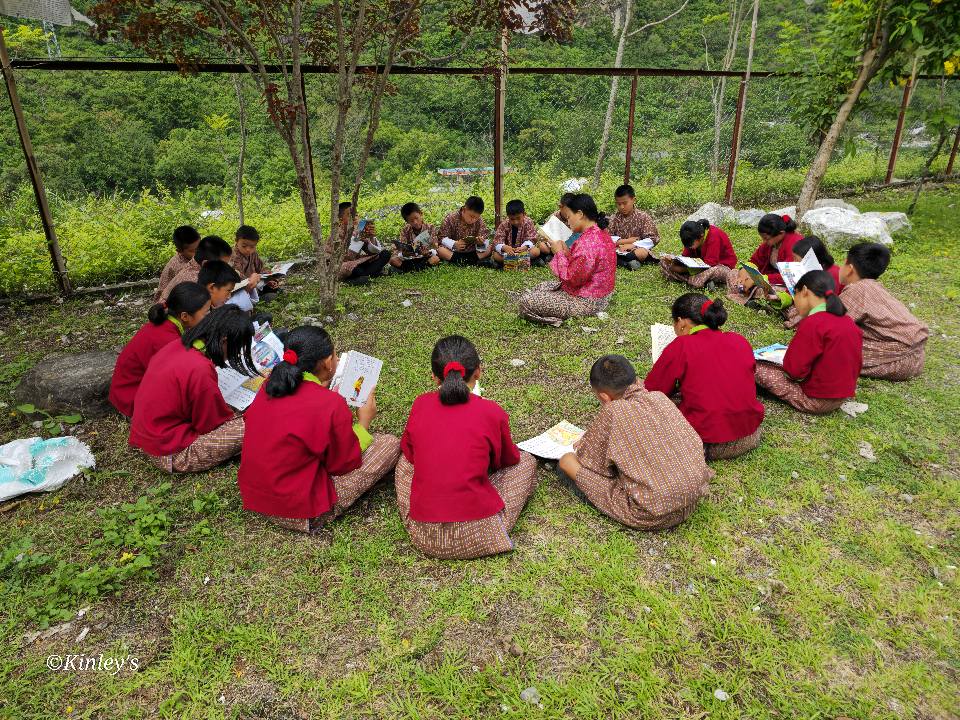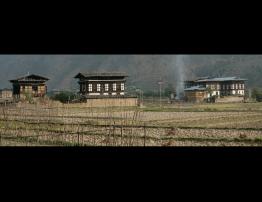Athang
Athang Gewog is one of the most remotest Gewog in Wangdue Phodrang. The settlement are widely scattered, Athang comprises of Five chewogs, (Jarogang-Zawa, Lopokha-Phaktakha, Lomtshokha, Rukha-Samthang and Lwa-Lamga).
All the chewogs are connected with farm roads, making farmers easy accessible to market and acquiring other services from Geog and Dzongkhag. Two villages (Yuetamo and Dhahi) are yet to be connected with farm road. Athang Gewog consists of 198 households with the population of 793 as per the PHCB-2018 sparsely settled on an estimate area of 746 sq km.
Athang Gewog enjoys dry sub-tropical climate with altitude ranging from 1000 to 3500 meters above sea level with high potential for live stock produce and best known “Smoked Fish” (Nga dosem).
Effort are doubled in the formulation of Tenth Five Year plan to alleviate poverty inducing the values of gross national happiness in the veins of Athaps and taking the roads of middle path to development. The Tarayana Foundation headed by Her Majesty queen mother Ashi Dorji Wangmo Wangchuk, an NGO funded the Rukhaps to build two storied house mobilizing labor within the four villages. The Zimpons Office has granted financial assistance to six destitute with monthly payment of Nu 1200/- through Gewog administration.
Total of 85.9 KM farm road has connected every village together and to the centre. Rukha-Samthang chewog has been connected with two Bailey Bridge, one each over Punatsangchu and Harrachu river at Taksha. These two bridges has replaced the suspension bridge and made easy to ply motor and transportation the goods.
The Gewog administration has sixteen staffs including elected personnel. They are the Gup, Mangmi, five Tshogpas, the Gewog administrative officer, three RNR extension officers, Gewog accountant, Geog Engineer and Gewog clerk (Geydrung).
Gewog at a glance
|
1 |
Gewog |
Athang |
|
2 |
Gewog centre |
Dogyephu |
|
3 |
No. of villages |
26 |
|
4 |
No. of chiwog |
5 (as per ECB delimitation) |
|
5 |
Total No. of household |
174 (As per the Gewog census record) |
|
6 |
Total Population |
1980 |
|
7 |
No. of Schools |
1 CPS & 1 ECR |
|
8 |
No. of Bridges |
5 |
|
9 |
No. of BHU/ORC |
1 ORC up graded to Extended ORC & 1 ORC |
|
10 |
No. of Lhakhangs |
7 |
|
11 |
No. of Chortens |
4 |
|
12 |
Road connectivity |
Farm Road
|
|
13 |
Electricity facilities |
Out of 26 villages 24 has been electrified |
|
14 |
Soil type |
Sandy loam to loam and are in general fertile and good for cropping.
|
|
15 |
Climate |
dry sub-tropical climate with warm temperature |
|
16 |
Estimated area (sq. km) |
746 sq.km |
|
17 |
maximum altitude (meter above the sea level) |
3500 meters above sea level |
|
18 |
minimum altitude (meter above the sea level) |
1000 meters above sea level |
Details of Chiwogs:
|
Sl. No |
Name of the Chiwog |
Name of the Village |
No. of households * |
|
1 |
Zawa-Jarogang |
1. Jarogang 2. Zomba 3. Zawa 4. Yutama |
13 2 12 5
|
|
2
|
Lopokha-Phaktakha |
1. Lopokha 2. Phaktakha |
25 8 |
|
3 |
Lomtshokha |
1. Lomtshokha 2. Kago 3. Tashigatshel 4. Gyamdro 5. Bartsha 6. Shoba 7. Takshi |
5 5 1 1 2 12 4 |
|
4 |
Rukha |
1. Rukh 2. Samthang 3. Miktana 4. Harachhu 5. Kashachecko 6. Nazhina |
20 9 6 1 4 2 |
|
5 |
Lawa-Lamga |
1. Lawa 2. Lamga 3. Chinading 4. Thaphu 5. Manigang 6. Dahi |
9 7 5 7 2 2 |
|
Total |
167 h/h |
||
*The households given here are based on the number of gungs recorded in the Census Records
Potentials and Constraints
Although the terrain is mostly rugged, there is potential for expansion of area under cultivation in new areas, this will be made possible with land swapping which is already under progress. Athang geog has the potential to increase its yield levels by adopting the use of improved pest and disease tolerant high yielding crop varieties. It also has the potential to produce sub-tropical fruit plants and few other cash crops in the pocketed areas. With the construction of 18.4km Power tiller track there is huge potential for farm mechanization as most of the agriculture land is on gentle to moderate slopes.
PROGRAMS
COMMODITY PROGRAM
Food security sub-programs
Under this program, the farmers in the geog identified the following crop improvement activities as priority crops:
- Rice development
- Maize development
- Wheat development
- Oilseed & Legumes development
- Other minor cereals
For the above sub-programs the following activities were identified to enhance farmers’ knowledge on crop management for higher productivity:
- Farmers training on above listed crop production aspect with main emphasis on plant protection through IPM approach, post-harvest handling and marketing
- Mechanized Paddy weed management trial
- Field Days
- On-farm trial
- Promotion of improved and high yielding seeds (HYV) & short duration variety
- Replacement of degenerated seeds
Income Generating Sub-programs
Under this program following crop improvement program are prioritized by the farmers in the geog.
· Citrus development
· Vegetable development
· Potato development
· Medicinal & Aromatic plant developme
· Other fruits development
Accordingly the following activities are incorporated in order to enhance the farmers’ knowledge on crop management for higher productivity;
· Farmers training on above listed crops management, pest & disease management through IPM approach, post-harvest and marketing
· Demonstration of new varieties/technologies
· On-Farm trial of improved varieties/technologies
· Promotion of improved seeds/seedlings.
· Promotion of fruit plant like pear, peach and persimmon.
· Commercial production of vegetable
· Further promotion of Asparagus and passion fruit
· For diverse and more rural cash income, cultivation of low altitude medicinal and aromatic plant will be explored and promoted.( Example aru/baru/churu)
SUPPORT SERVICES PROGRAM
Under this program, the farmers in the gewog have identified a number of farm support services activities on priority basis, which are as follows.
· Post Harvest and marketing activities
· Plant Protection
· Farm Mechanization
· Land Management program
For the above sub-programs, the following activities are identified and prioritized by the farmers:
· To improve the efficiency and effectiveness of the marketing construction of marketing shed at Kamichu was initiated and was funded by Punatshangchu Hydro Power project I.
· To promote farm mechanization more intensively to address farm labour shortage and reduce cost of production power tiller and rice huller was provided to the people through REAP I project
FARM INFRASTRUCTURE DEVELOPMENT PROGRAM
Under this program, the farmers in the geog have identified a number of farm infrastructure development and improvement activities on priority basis, which are as follows.
· Rural Access development
· Irrigation and Water Management
The Objectives of these activities are;
· Improving the rural access through construction of farm roads and power tiller tracks to link the potential production areas to markets through complete government funding (on contract and departmental) and cost sharing (machinery from government and fuel & other cost by community)
· Investment in appropriate irrigation system and water management technologies for agriculture and horticulture development with focus on: Construction and renovation of irrigation channels.
The prioritized activities under each sub-program implemented in the 10th Five Year Plan are as follows.
Farm Road/PTT
4 km Gangphey to Taktsee PTT( cost sharing)
· 6.1km GC road Jarogang to Dogyephu
Construction/Renovation of Irrigation channels
· 1km kashachecko yuwa
· .5km Miktana yuwa
Renovation
1km Phaktakha yuwa
· 1km Samthang yuwa
· 3km Zawa yuwa
· 1.5km Rukha yuwa
· .5km Yutama yuwa
CAPACITY BUILDING PROGRAM
Human resource development:
Under this program, human resource development activities have been identified as per the prioritization of the farmers in the geog. The following are the activities under this program:
· Farmers study tour (within Geog & Dzongkhag)
· Farmers group organization
Accordingly, the objective of the sub-program has been formulated as follows:
· To share experience with other farmers and to expose the farmers to other demonstrative activities within the geog and Dzongkhag to inculcate learning by seeing.
· To train & support the farmers group in raising the start-up capital and to help market their products as a group.
The prioritized activities under this sub-program as follows:
· Study tour within the geog and Dzongkhag
· Formation of co-operative.
Crop Production
|
Crops
|
Area in Acres
|
Production in MT |
Yield (kg/acres)
|
|
Cereals |
|
|
|
|
Wheat |
31.79 |
59.04 |
1.86 |
|
Barley |
3.29 |
4.64 |
1.41 |
|
Buckwheat |
12.92 |
20.46 |
1.58 |
|
Millet |
7.29 |
9.42 |
1.29 |
|
Potatoes |
6.26 |
70.34 |
11.24 |
|
Mustard |
0.53 |
0.96 |
1.80 |
|
Paddy |
83.29 |
380.92 |
4.57 |
|
Maize |
25.20 |
58.14 |
2.31 |
|
Vegetables |
|||
|
Chilly |
12.24 |
19.84 |
1.62 |
|
Cabbages |
00 |
0.00 |
0 |
|
Cauliflower |
0.0 |
0.00 |
0 |
|
Carrot |
0.00 |
0.00 |
0 |
|
Radish |
1.00 |
0.42 |
0.42 |
|
Fruit trees |
|||
|
Apple |
200 trees |
0.25 |
17.91 |
|
Citrus |
2193 trees |
21.93 |
26.91 |
|
Peach |
300trees |
0.97 |
26.89 |
|
Pear |
100 trees |
0.81 |
36.82 |
|
Walnut |
100 trees |
0.02 |
15.00 |
Education Statistics
|
Sl.no |
Name of School |
Location |
Establishment |
Teaching Staff |
Students |
Non-Teaching staff |
Water Supply |
Electricity |
Road Connectivity |
||
|
M |
F |
B |
G |
||||||||
|
1 |
Adha ECR |
Lopokha |
1991 |
1 |
0 |
8 |
3 |
0 |
Yes |
Yes |
8 hours walk from the nearest road head |
|
2 |
Singye Namgyal CPS |
Miktana |
2006 |
6 |
0 |
69 |
61 |
3 |
Yes |
Yes |
Connected with farm road (seasonal |
KIDU REPORT
Kidu Recipient (2015)
|
Sl. no |
Name |
Village |
CID no |
House no |
Thram no |
Remarks |
|
1 |
Namgyel Dema |
Rukha |
11901001057 |
Tsha-1-84 |
nil |
destitute |
|
2 |
Wangchuk Dema |
Rukha |
11901001031 |
Tsha-1-82 |
161 |
destitute |
|
3 |
Penjor |
Jarogang |
11901000201 |
Tsha-1-128 |
1 |
destitute |
|
4 |
Migmar |
Lopokha |
11901000621 |
Tsha-1-19 |
44 |
destitute |
|
5 |
Passang |
Lopokha |
11901000674 |
Tsha-1-27 |
09 |
destitute |
Cultural
I. Morokha lakhang
Buddhism is the spiritual heritage of Bhutan, which promotes among others the principles and values of peace, non-violence, compassion and tolerance. It’s the duty of every citizen to preserve, protect and promote our rich cultural heritages of the country, including monuments, places, objects,languages, literature, arts, music and religion. In order to preserve, protect and promote the rich cultural heritage, Morokha lakhang has been constructed for the people of two chewogs or 43 household. It is said that the lakhang has been constructed by Lam Gewa Tenzin Drakpa the than the reign carnation of Pema Lingpa. The reconstruction of the lakhang has been incorporated in the Gewog Plan for the FY 2008- 2009 and was a spill over activity for FY 2009 -2010 but could not be completed due to insufficient budget. The gewog administration could not carry out the work in the FY 2010-2011 due to budget constraints and in order to complete the lakhang we appraised CSO for Funding facility. We were granted a sum of Nu. 1500000/- (fifteen lakhs) only by CSO and the work has been awarded to Mr. Wangchuck from Lopokha village through Community Contract. The lakhang is considered as the winter resident of Gangtey Telku beside Gangtey lakhang. On the one side of the mountain there is a big cliff which is often referred as a place for meditation. It is said that Khandom Manderava was found weaving there and one can clearly see the picture of a loom curved on a rock. The Lakhang got its name after Khandom Manderava.
The main deity in the lakhang is “Channa Dorji”. It is said that Lekpey Dendup was invited by the people of Adha and he brought the statue or Ku from Gangtey monastery. The statue or Ku is originally from Tang Mebartshog. It’s believed that the poison has been engulfed by the statue or ku and there is no snake bites recorded in the history of Adha till date. The people in this chewogs have taken the name from the statue or Ku and majority of their names are Chado. One of the most prominent examples is Dasho Adap Chado, Judge of Haa district court.
II. Jarogang lakhang:
The Jarogang lhakhang is one of the most auspicious lhakhang in Athang Gewog. It is said that when Zhabdrung Rinpochee the founder of Bhutan was about to leave the country because of the internal rival Lam Kha Nga as well his native rival the supporter of Tshangpa Jaray, our main deity Mahakala manifested himself in raven showing gesture not to leave since then the place was known as Jarogang . The exact year of the construction of the lhakhang is not known but was renovated 15 years back. Now we have a monastic school with the support from Central Monastic Body. An old cypress tree is still grown nearby when Zhabdrung Rinpochhe left that in seventeenth century. The cypress tree elderly person said was His walking stick. There are also rumors saying like the main Nangten Rangung Kharsapani was kept there for some time when it wasn’t safe at Punakha.
About fourteen houses have mushroomed around the lhakhang on that divine hill surrounded by their agricultural land.
III. Phaktakha Lakhang:
Phaktakha lakhang was constructed by Wangzo Kochu from Lopokha, Sirigang and the exact year of construction is not known. The lakhang has been handed over to the community and the minor maintenance works are done by the community. Some elderly people say that the lakhang has been constructed 110 years back, but no major maintenance has been done till date. The main statue in the lakhang is “Chuzi zhee”. The 18th of September 2011 earthquake has severely damaged the walls, paintings, centre beam and main entrance.
IV. Shoba Lakhang
The exact year of the construction of Shoba lakhang is not known. The lakhang is taken care by the community and no major maintenance has been done till date. The main statue in the lakhang is “Chuzi zhee”.
Institutions
Staff





Tourism
Contact us
- Dzongkhag Administration Wangdue Phodrang, Bhutan
- Dzongdag Post Box No: 1305
- PABX:02-481408/02-481686
- Fax No: 02-481380




